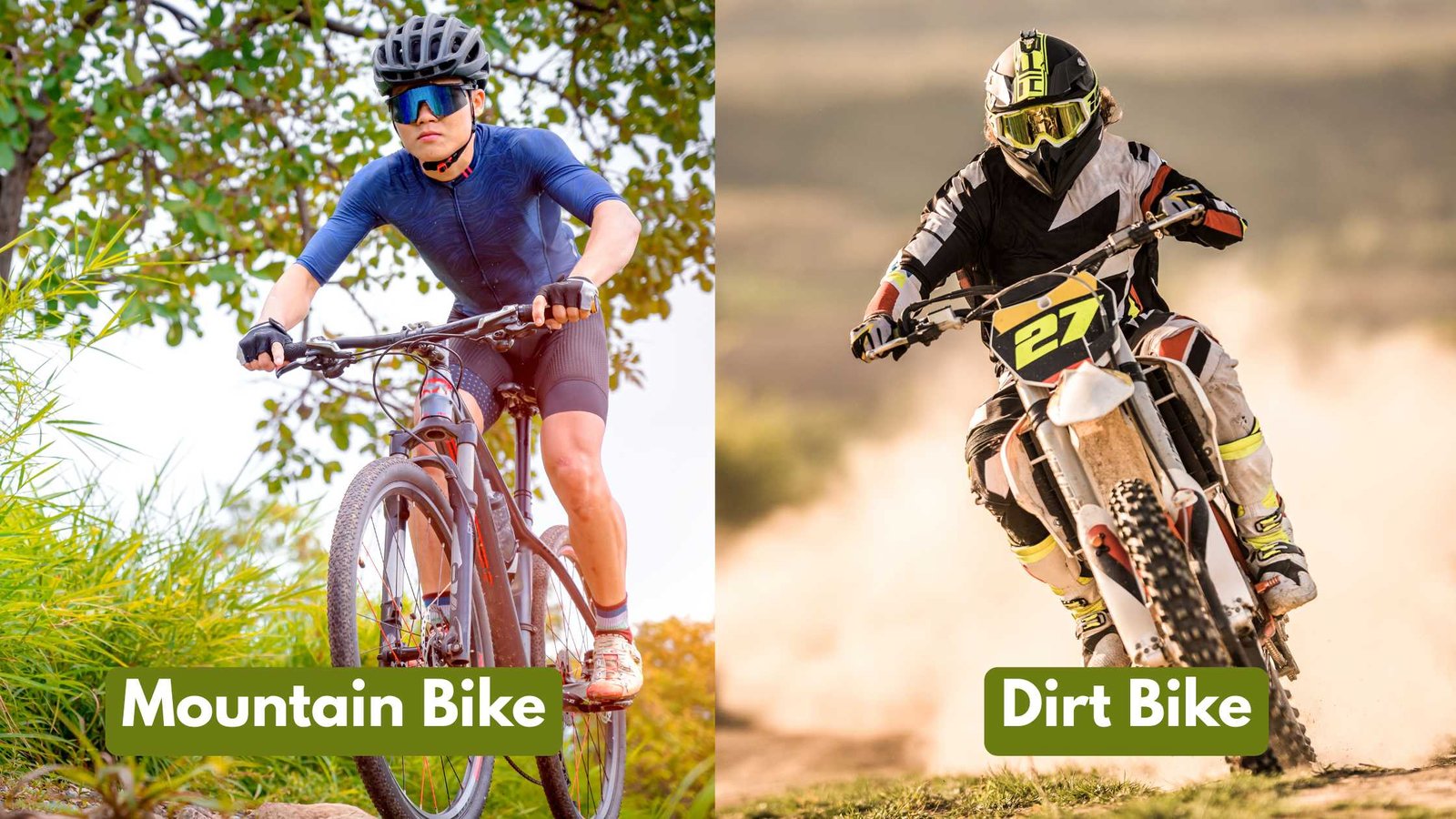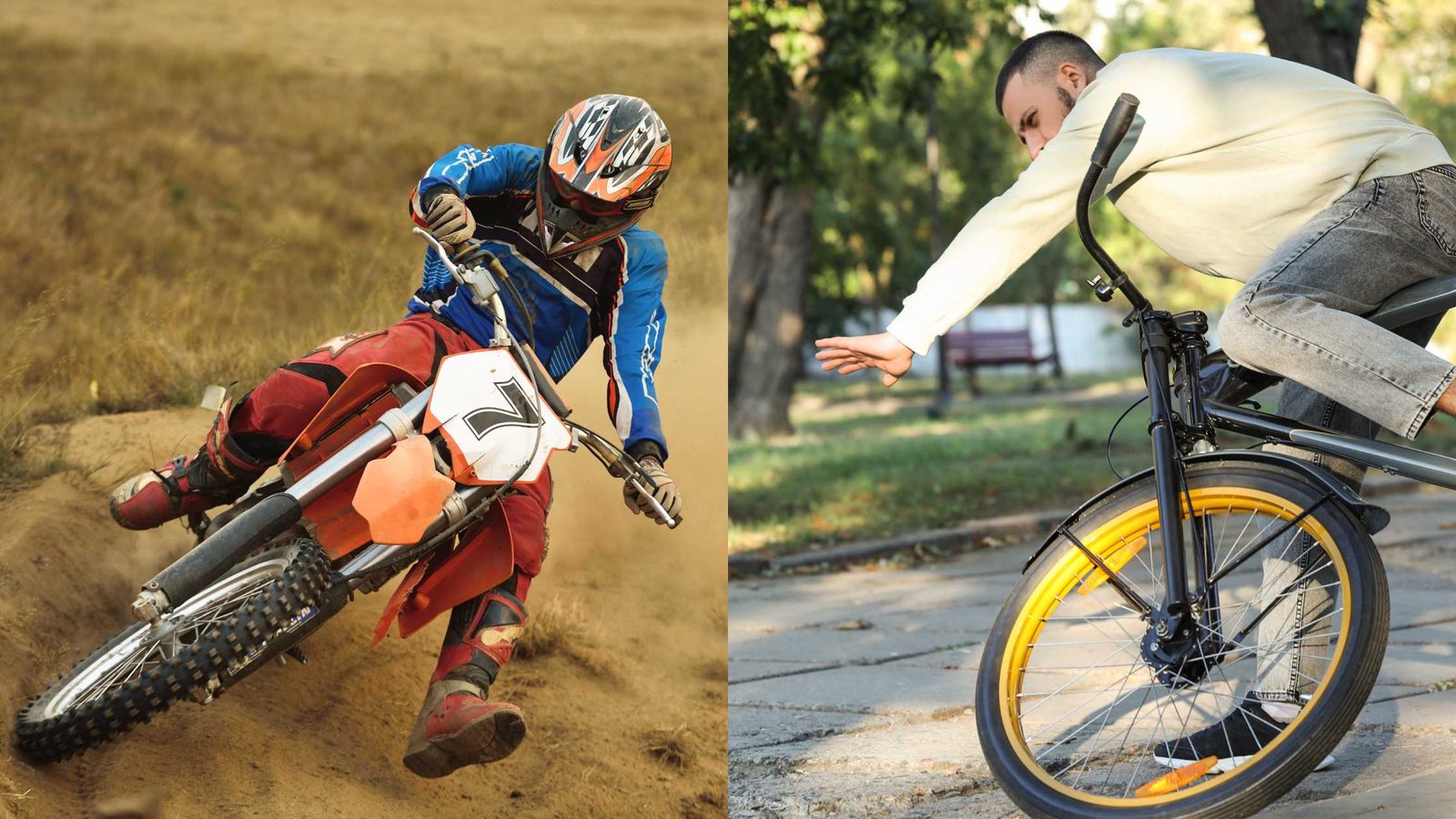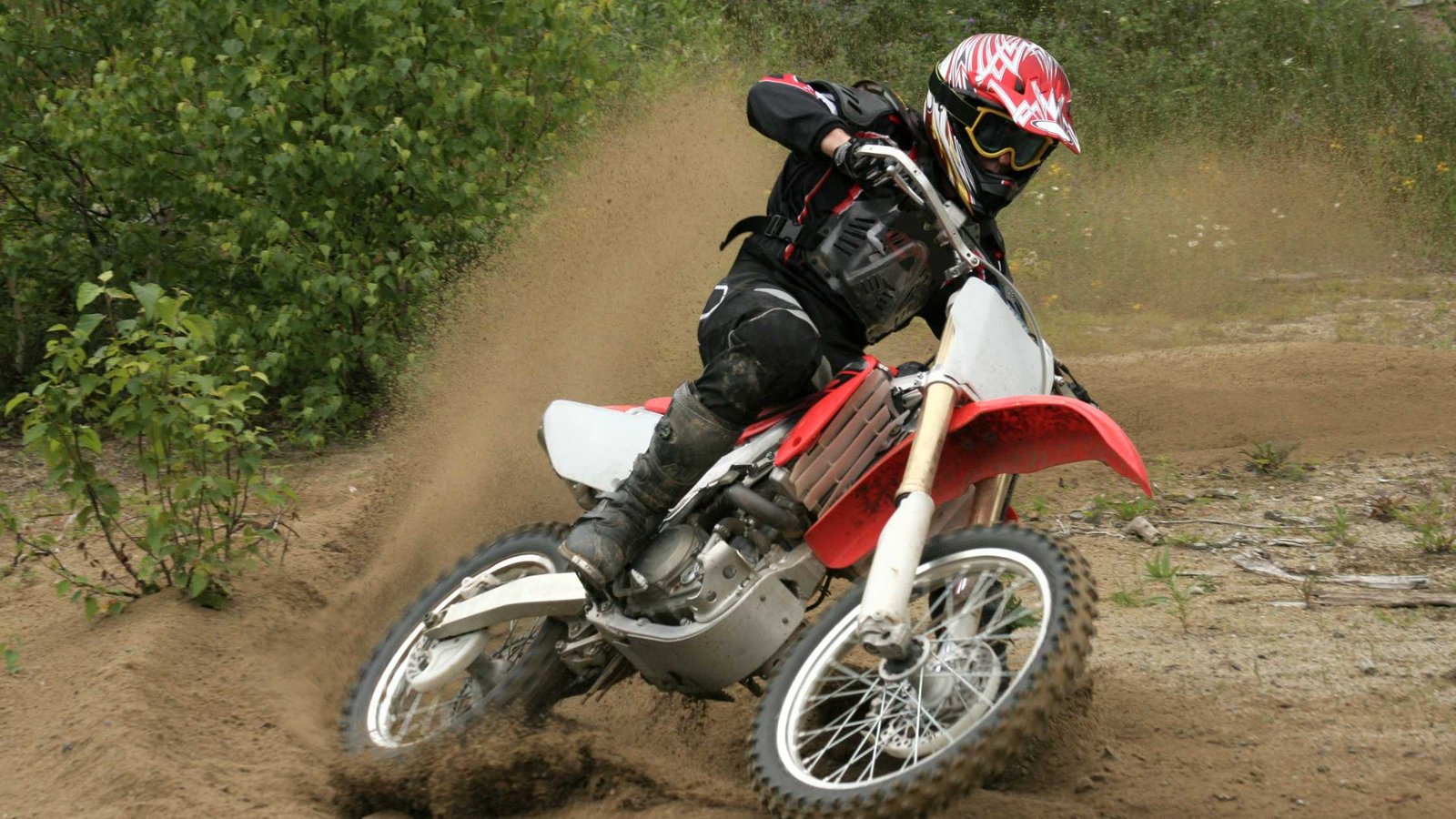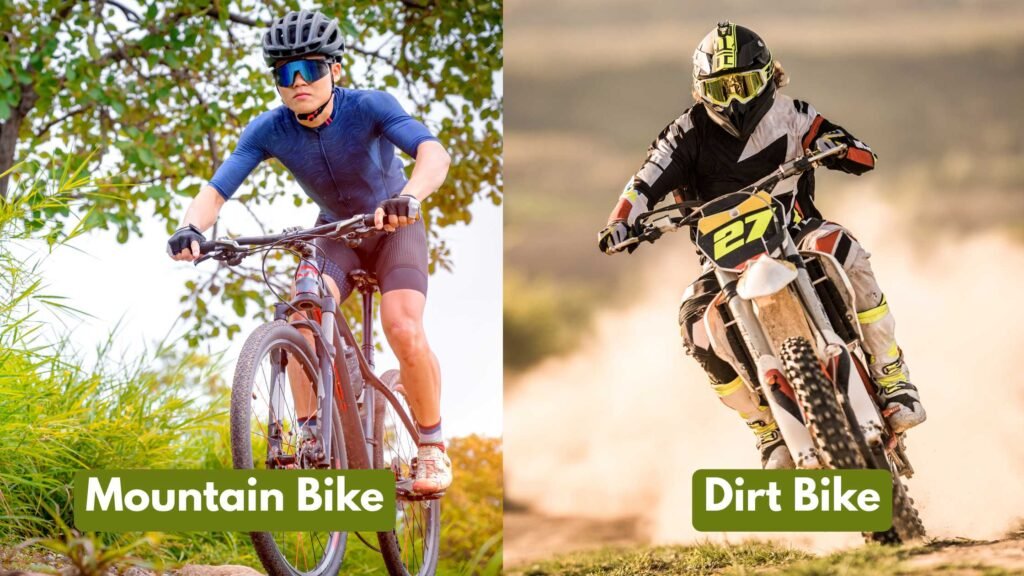Dirt Biking is more dangerous than Mountain biking. Because if we see Dirt Biking deaths per year compared to Mountain biking, dirt bikes usually have higher fatal accident rates.
But at the same time, mountain biking injuries are far more common because riders crash more often on trails.
So, when it comes to danger, you have to see two things: frequency of injuries and severity of accidents.
Understand the Sports: MTB vs Dirt Bike

Before we talk about dangers, let me clear one thing. Mountain biking (MTB) and dirt biking (motorcycles) are not the same.
- Mountain Biking: In this, you will be riding a non-motorized cycle on natural trails, rocks, roots, and descents. And, it requires more strength, stamina, balance, and technique.
- Dirt Biking: You’re riding a motorcycle off-road, which is powered by an engine, and because of that, it involves higher speeds, jumps, and motocross-style trails.
So, right from the beginning, you can guess the risk factors are different.
Dirt biking has higher speeds and more severe crashes; on the other hand, mountain biking has more frequent falls and injuries.
Frequency of Accidents

When you check the “ Is mountain biking dangerous reddit discussions, you’ll often see bikers saying they crash all the time. And discussing scrapes, broken bones, and sometimes even concussions.
Why? Because mountain biking trails are unpredictable:
- Loose rocks, roots, and mud
- Sharp turns on downhill descents
- Steep climbs where balance is tough
On the other hand, dirt biking accidents are less frequent for many riders because the terrain is built for motorcycles.
But when they happen, they are seriously worse.
So what I say:
- Mountain Biking: A rider might have to face frequent accidents, but most are minor.
- Dirt Biking: A rider will face fewer frequent accidents, but they will be more severe.
Btw, if you want to learn how to handle MTB trails safely, check this guide on Mountain Biking Skills.
Severity of Accidents
Now, let’s talk about seriousness.
Mountain Biking Injuries:
- The most common injuries that bikers can get are bruises, scrapes, shoulder dislocations, broken collarbones, and wrist fractures.
- In most cases, fatal accidents are rare, but they do happen, mostly when you ride on extreme downhill or freeride trails.
Dirt Biking Injuries:
- They’re very risky; a rider can even get head trauma, spinal injuries, and internal bleeding because of the speed bike’s weight.
- According to some studies, dirt bike crashes often require hospital care compared to MTB crashes.
To get an idea of the kind of injuries MTB riders usually face, you can check Mountain Biking Injuries.
Speed: The Real Risk Factor

One of the biggest differences between the two sports is speed.
- Mountain Bikes: An MTB rider usually reaches 10 to 20 mph on trails. On steep downhills, just 25–35 mph.
- Dirt Bikes: Dirt bikers can easily hit 40 to 60 mph, and in motocross races, even more.
So when a crash happens:
- A mountain biker will fall at 20 mph, which might break bones, cause some bruises, or maybe a concussion.
- When a dirt biker crashes at 50 mph, the biker might even get life-threatening injuries. (Gear will play a huge role here)
That’s why, when we see Mountain Biking deaths per year, the number is usually lower than dirt biking fatalities, even though MTB accidents happen more often.
Risk Perception: What Riders Say
If you read Is mountain biking dangerous reddit threads, you’ll find something interesting. Here is what I found:
- MTB riders say they expect to fall — it’s part of the sport. Most accept cuts and bruises as “normal.” (And I do agree with them)
- Dirt bikers, on the other hand, often mention how even small mistakes can result in massive accidents because of the speed and machine power.
So from a rider’s perspective, mountain biking feels safer but riskier in numbers, while dirt biking feels scarier because of the consequences.
Protective Gear Matters
One big difference is gear.
- Mountain Biking: Most mountain bikers only wear a helmet and gloves. And they rarely wear pads. But on casual trails, all of them (I did that too).
- Dirt Biking: Riders usually wear full-body protection — helmets, chest protectors, boots, and knee braces.
The funny part? Even with less protection, MTB crashes are usually survivable. Dirt biking requires heavy protection because the crashes can be brutal.
If you’re new to MTB, you should never compromise on safety. Here’s a complete Mountain Bike Helmet Guide.
Mountain Biking Deaths Per Year vs Dirt Biking Fatalities

Now, let’s talk statistics.
- Mountain Biking deaths per year are estimated at a few dozen worldwide, with thousands of reported injuries.
- Dirt Biking fatalities are much higher compared to MTB, especially in motocross and off-road racing. Some reports suggest hundreds of dirt bike deaths every year, especially among young riders.
That shows one clear difference: mountain biking has more accidents but fewer deaths, while dirt biking has fewer accidents but more deaths.
Which Is More Dangerous for Beginners?
Let’s say you’re just starting.
- If you’re a beginner mountain biker, while mtb biking, you will fall a lot. And you might get scratches, bruises, maybe a sprained wrist. But if you stick to Beginner-Friendly Trails, your risk stays low.
- If you’re a beginner dirt biker, even on easy terrain, the machine’s power and weight can throw you off badly. That’s why most experts say dirt biking is not beginner-friendly without proper supervision.
So for absolute beginners, mountain biking is safer.
Which Is More Dangerous for Experienced Riders?
Here’s where things flip.
- Experienced MTB riders often push themselves on downhill or enduro trails. These trails are very risky, with higher crash potential.
- Experienced dirt bikers know their machines, but the risk is always higher because of extreme speeds.
In the end, both become dangerous at high levels — but dirt biking still has a higher fatality rate.
If you’re starting MTB at an older age, here’s a guide on Starting Mountain Bike at 40.
Trail Environment
The trails also make a big difference.
- Mountain Biking Trails: On technical trails, you will face rocks, roots, drops, and switchbacks. So, chances are higher of falling, but usually, they’re not fatal. Btw, you can also explore Scenic Mountain Bike Trails if you prefer safer yet adventurous rides.
- Dirt Biking Tracks: They’re especially designed for high-speed jumps, sharp turns, and motocross racing. So, any crashes will involve higher momentum.
So the environment itself makes dirt biking inherently riskier in terms of consequences.
Fitness & Body Impact
One more thing people often forget:
- Mountain biking is a workout. You build stamina, strength, and endurance while riding. (See Build Stamina for Mountain Biking).
- Dirt biking, however, is less about cardio fitness and more about handling the machine.
This means MTB crashes often involve a fitter’s body, which can sometimes recover quickly from injuries. Dirt bike crashes, though, put the body under heavier impact stress.
Mental Stress & Fear Factor
Fear plays a role, too.
- Mountain Biking: You fear the trail, the rocks, the steep descents. But you will easily overcome fear as your skills improve.
- Dirt Biking: The fear is about the machine’s speed and potential for fatal crashes. That fear often stays even for experienced riders.
That’s why many people say dirt biking feels more dangerous, even if you’re good at it.
Cost of Mistakes
It doesn’t matter which support we focused more on, mountain biking or dirt biking. Mistakes happen in both sports.
- Mountain Biking Mistake: You misjudge a corner, hit a root, or brake late. You fall, get scratched up, and maybe break a bone.
- Dirt Biking Mistake: You throttle too hard, lose control, and crash at high speed. The result could be dangerous.
So the cost of mistakes in dirt biking is higher.
Mountain Biking vs Dirt Biking: Which One Should You Choose?
If safety is your main concern:
- Choose Mountain Biking for fun, fitness, and lower fatality risk.
- Choose Dirt Biking if you’re okay with higher danger but want adrenaline and speed.
Remember: Every sport has risks. The best thing you can do is stay prepared, wear gear, and ride within your limits.
Conclusion
So, is mountain biking more dangerous than dirt biking? Well, it’s not that simple. Both are risky, but in different ways.
In mountain biking, you’re going to fall more often; it’s normal, but most of the time you’ll just get scratches, bruises, maybe a broken wrist if unlucky.
Dirt biking crashes don’t happen every day, but when they do, they’re usually way more serious because of speed and heavy machines.
If you ask me, mountain biking feels safer, plus you stay fit and enjoy nature.
Dirt biking is more adrenaline, more thrill, but also more life-risking.
So it’s all about what you want. Just don’t forget — no matter which one you pick, gear is a must, and ride safe.
FAQs
Here are a few questions and their answers about dirt biking and mountain biking.
Is mountain biking dangerous compared to dirt biking?
Yes, it is dangerous, but not in the same way. In MTB, you crash a lot but survive fine. In dirt biking, one mistake can cost you big. That’s why people feel dirt biking is scarier.
How many mountain biking deaths per year?
Honestly, not many. Mountain biking deaths per year are rare compared to dirt biking. But injuries? Oh yes, they happen daily — collarbone, wrist, knee. So, expect injuries, not death.
Is dirt biking safe for beginners?
Not really. If you’re a beginner, mountain biking is way safer. Dirt bikes are heavy and fast, and they can throw you off badly.
If you’re new, better try Beginner-Friendly MTB Trails instead of jumping on a dirt bike.
Which one should I do if I’m older, MTB or dirt bike?
Mountain biking. 100%. If you’re 40, 50, or even 60, go with MTB. It’s easier on your joints, better for stamina, and honestly safer.
Dirt biking at that age? Too risky. But still you can try.

Ali is the founder of Mountain Bike Insider and an passionate rider with years of hands-on experience in mountain biking. From testing gear to exploring trails, Ali writes based on real riding knowledge to help others make smart, safe, and enjoyable biking choices. Every guide is built on research, personal use, and a passion for the sport.







